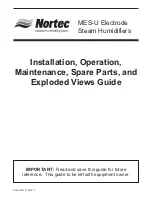
1. Unplug the unit; remove the cabinet side and the electrical connection cover on the compressor top.
2. Plug in the unit and turn the humidity control to ON. Check for volts from compressor terminal R to overload
terminal 3 using an AC voltmeter. If correct voltage is present, go to step 3. If no voltage, there may be a loose
connection in the compressor circuit. Test each component for continuity. See the appropriate section if a defect is
suspected.
3. Unplug the unit, and then disconnect the red and yellow wires from compressor terminals R & S. Using an ohmmeter
check continuity between the points listed below.
4. Compressor terminals C and S: No continuity indicates an open start winding. The compressor must be replaced.
Normal start winding resistance is 3 to 7 ohms.
5. Compressor terminals C and R: No continuity indicates an open run winding. The compressor must be replaced.
Normal run winding resistance is .5 to 2 ohms.
6. Compressor terminal C and overload terminal 1: No continuity indicates a defective overload lead.
7. Overload terminals 1 and 3: If there is no continuity, the overload may be tripped. Wait 10 minutes and try again. If
there is still no continuity, it is defective and must be replaced.
8. Compressor terminal C and compressor case: Continuity indicates a grounded motor. The compressor must be
replaced.
9. Disconnect the wires from the run capacitor. Set the ohmmeter to the Rx1 scale. The capacitor is shorted and must
be replaced if continuity exists across its terminals. If there is no needle movement with the meter set on the
Rx100000 scale, the capacitor is open and must be replaced.
10. Reconnect the wires to the compressor and capacitor. Plug in and turn on the unit. If the compressor fails to start,
replace the run capacitor.
11. If the unit still does not start, adding a hard-start kit (relay & capacitor) will provide greater starting torque. If this
doesn't work, the compressor has an internal mechanical defect and must be replaced.
7.6B Replacing a Burned Out Compressor
The refrigerant and oil mixture in a compressor is chemically very stable under normal operating conditions. However,
when an electrical short occurs in the compressor motor, the resulting high temperature arc causes a portion of the
refrigerant oil mixture to break down into carbonaceous sludge, a very corrosive acid, and water. These contaminants
must be carefully removed otherwise even small residues will attack replacement compressor motors and cause failures.
The following procedure is efective only if the system is monitored after replacing the compressor to insure that the
clean up was complete.
1. This procedure assumes that the previously listed compressor motor circuit tests revealed a shorted or open winding.
2. Remove and properly dispose of the system charge.
DO NOT vent the refrigerant or allow it to contact your eyes or
skin.
3. Remove the burned out compressor. Use rubber gloves if there is any possibility of contacting the oil or sludge.
4. To facilitate subsequent steps, determine the type of burn out that occurred. If the discharge line shows no evidence
of sludge and the suction line is also clean or perhaps has some light carbon deposits, the burn out occurred while
the compressor was not rotating. Contaminants are therefore largely confned to the compressor housing. A single
installation of liquid and suction line flter/driers will probably clean up the system.
If sludge is evident in the discharge line, it will likely be found in the suction line. This indicates the compressor burned
out will running. Sludge and acid have been pumped throughout the system. Several changes of the liquid and suction
flter/driers will probably be necessary to cleanse the system.
5. Correct the system fault that caused the burn out. Consult the factory for advice.
18







































